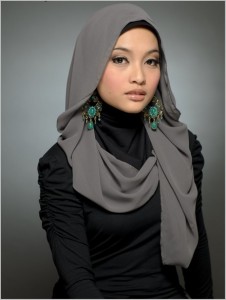 As summer approaches, Muslim women all over the United States are trying to find the right solution for their wardrobe needs. At the center of the Islamic woman’s wardrobe is the hijab, and finding one that is suitable for the summertime can be a big hassle for a lot of women. There are plenty of hijab styles available, such as the Shyla and Mona styles, but to deal with the heat, fabric choice is the most important choice that must be made. When it comes to hijab fabrics there are three main choices: cotton, wool and silk, each with its own unique benefits and faults.
As summer approaches, Muslim women all over the United States are trying to find the right solution for their wardrobe needs. At the center of the Islamic woman’s wardrobe is the hijab, and finding one that is suitable for the summertime can be a big hassle for a lot of women. There are plenty of hijab styles available, such as the Shyla and Mona styles, but to deal with the heat, fabric choice is the most important choice that must be made. When it comes to hijab fabrics there are three main choices: cotton, wool and silk, each with its own unique benefits and faults.
Cotton
By far the cheapest option available, cotton is the hijab that most women choose. Cotton fabrics are lightweight and they are breathable, so that heat from the head is able to escape through the fabric and cool air from the outside is able to penetrate the cotton. As the temperature goes up, cotton fabrics adapt to the changes easily. Cotton can absorb moisture without becoming extremely heavy, so when the wearer of a cotton hijab sweats, the sweat does not become unbearable. The problem with cotton is that it wrinkles very easily, so cotton does not always look good as the day goes on. To combat this issue, most cotton garments are actually cotton and polyester blends that give the cotton a little more strength and help to keep the garment looking good over the course of the day.
Wool
Wool is one of the oldest textiles known to humanity, and it has been worn by people all over the world for thousands of years. With a variety of animals to harvest for their wool, clothiers who choose to make garments out of wool have choices in the texture and weight of a wool garment. The wool itself makes hijabs that are exceptionally soft, making the hijab less irritating on the face than some other garments. Wool is also a very warm fabric that maintains the heat of anything inside. This heat makes wool hijabs very poor choices for the summer, but they are excellent choices for winter wear. The real problem with wool is that it can lose its shape easily. These garments tend to stretch or wear flex more than any other type of hijab fabric, so women who do not take care of their woolen hijabs will see a very short life span for the garment.
Silk
The word “silk” just implies class and elegance, and for centuries silk has been used for high quality dresses and other formal wear. Fortunately, silk is cheap enough that it can also be used for every day wear, such as hijabs. Silk garments are typically viewed as elegant and look nicer than most of the other fabrics available for hijabs. However, these garment also have the versatility to be worn for everyday use and the fabric will last a very long time. The problem with silk is that it requires very special laundering. If the fabric was prewashed and pre-machine dried, then there is nothing to worry about, but if the silken hijab was not pre-laundered, there are a number of steps to take to keep the fabric clean. Owners of a silken hijab will need to follow all of the washing instructions inside the garment.
Summertime means choosing the right fabric for hijabs for many Muslim women throughout the world. A fabric that is too heavy will be uncomfortable to wear for a long period of time, while the hassles of maintaining other garments may outweigh the benefits.
I am Abal Najareen and I wrote this as a quick guide for American women who wish to follow their religious convictions when it comes to Islamic clothing choices.

